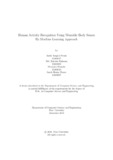| dc.contributor.advisor | Alam, Md. Golam Rabiul | |
| dc.contributor.author | Promi, Sadia Tangim | |
| dc.contributor.author | Rahman, Md. Zahidur | |
| dc.contributor.author | Mostafa, Moumita | |
| dc.contributor.author | Harun, Sarah Bintay | |
| dc.date.accessioned | 2020-10-11T05:45:24Z | |
| dc.date.available | 2020-10-11T05:45:24Z | |
| dc.date.copyright | 2019 | |
| dc.date.issued | 2019-12 | |
| dc.identifier.other | ID: 15301017 | |
| dc.identifier.other | ID: 15101122 | |
| dc.identifier.other | ID: 15201023 | |
| dc.identifier.other | ID: 14101067 | |
| dc.identifier.uri | http://hdl.handle.net/10361/14054 | |
| dc.description | This thesis is submitted in partial fulfillment of the requirements for the degree of Bachelor of Science in Computer Science, 2019. | |
| dc.description | Cataloged from PDF version of thesis. | |
| dc.description | Includes bibliographical references (pages 48-51). | |
| dc.description.abstract | The prevalence of electronics devices and the increase in computer resources, like
networking, storage, accessibility and sensor capacity, have significantly improved
the lives of humans. Now a days most smart devices have a number of strong
sensing equipment, such as sensors for movement, position, connection and direction.Basically, movement or motion tracking sensors are commonly been using to
classify the physical activities of humans. This has opened entryways for a wide
range of and intriguing applications with regards to a numerous zones, for example,
human healthcare well being and transportation, security system. In this point of
view, this research gives a complete, best in class audit of the present circumstance
of human activity recognition (HAR) approaches with regards to inertial sensors in
electronic portable smartphone devices. Our research started by analyzing the principles of human activities and the entire historical events based on electronics deices
such a smartphone, which demonstrate the development in this area over the past
few years. Our approach concentrates on the introduction of the means of HAR arrangements with regards to sensors. We propose a methodology which incorporates
traditional signal processing techniques with deep learning tools to robustly classify activities from wearable body sensor data. Our proposed methodology achieves
a validation accuracy of 96.26% in the WISDM Dataset and is able to recognize
human activity from wearable body sensor data robustly. | |
| dc.description.statementofresponsibility | Sadia Tangim Promi | |
| dc.description.statementofresponsibility | Md. Zahidur Rahman | |
| dc.description.statementofresponsibility | Moumita Mostafa | |
| dc.description.statementofresponsibility | Sarah Bintay Harun | |
| dc.format.extent | 51 pages | |
| dc.language.iso | en_US | en_US |
| dc.publisher | Brac University | en_US |
| dc.rights | Brac University theses are protected by copyright. They may be viewed from this source for any purpose, but reproduction or distribution in any format is prohibited without written permission. | |
| dc.subject | Human Activity Recognition | en_US |
| dc.subject | HAR | en_US |
| dc.subject | Machine Learning | en_US |
| dc.subject | Convolutional Neural Network | en_US |
| dc.title | Human Activity Recognition using wearable body sensor by machine learning approach | en_US |
| dc.type | Thesis | en_US |
| dc.contributor.department | Department of Computer Science and Engineering, Brac University | |
| dc.description.degree | B. Computer Science | |

